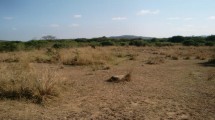Summary
A simple model is preesented which simulates the consumption of superficial dead wood in a desert grassland by a single termite species over a period of one year. Temperature-dependent functions of termite foraging intensity and wood consumption are most critical. The model was designed to run on mean daily temperature and daily rainfall. The model predicts thatHeterotermes aureus forag ers were able to make 4.61×1010 visits to the suurf ace per hectare during the year of simulation. It estimates that there were only seven days during this period thatH. aureus did not forage. It calculates that this species remooved dead wood at the rate of 78.9 kg/ha/yr, which represents 3.7 perenct of the standing crop biomass and 17.5 percent of the annual production of superficial dead wood. The importance of this termite is emphasized by its removal of preferred species of wood.
Zusammenfassung
Dargestellt wird ein einfaches mathematisches Modell, das Verzehrung des in einem semi-ariden Grasland in Arizona auf der Oberfläche liegenden abgestorbenen Holzes durch eine einzelne Temitenart im Zeitraum eines Jahres voraussagt. Von höchster Bedeutung sind die temperaturabhängigen Funktionen der Intensität der Futtersuche und der, Holzverzehrung der Termiten. Das Modell wurde so aufgestellt, daß es vom Tagestemperaturmittel und der täglichen Niederschlagsmenge abhängig ist. Das Modell sagt voraus, daß futtersuchendeHeterotermes aureus während des Simulations jahres die Oberfläche 4,61×1010 mal pro Hekta besuchen. Es wird errechnet daßH. aureus nur an 7 Tagen im Jahre nicht auf die Futtersuche geht. Ferner lässt sich errechnen, daß diese Termitenart 78,9 K/Ha/J abgestorbenes Holz verzeht, was 3,7% der stehenden Biomasse und 17,5 % der jährlichen Produktion toten Holzes darstellt. Die Bedeutung dieser Termite wird durch die von ihr verursachte Entfernung von bevorzugten Holzarten betont.
Similar content being viewed by others
References
Baroni-Urbani (C.), 1972. — An example of the usefulness of simulation techniques in ecological researches: the study on food consumption of a large ant community.Ekol. Pol., 20, 33–42.
Basson (N. J. C.), 1972. — Beskadiging van natuurlike wieveld in die Noord-Vrystaat deur die gras draer-termiet,Hodotermes mossambicus (Hagen).Phytophylactica, 4, 67–72.
Benemann (J. R.), 1973. — Nitrogen fixation in termites.Science,181, 164–165.
Bodine (M. C.), 1973. — The impact of the termiteGnathamitermes tubiformans on rangeland herbage dynamics.M.S. Thesis, Texas Tech. Univ., Lubbock, Texas, U.S.A., 39 p.
Breznak (J. A.), Brill (W. J.), Mertins (J. W.) andCoppel (H. C.), 1973. — Nitrogen fixation in termites.Nature, 244, 577–580.
Coaton (W. G. H.), 1951. — The snouted harvester termite; natural mortality as an aid to chemical control.Farm. S. Afr.,26, 263–267.
De Bruyn (G. J.) andDe Bruin (M. K.), 1972. — The diurnal rhythm in a population ofFormica polyctena Först.Ekol. Pol., 20, 117–127.
Hadley (M.), 1972. — Perspectives in productivity studies, with special reference to some social insect populations.Ekol. Pol.,20, 173–184.
Haverty (M. I.), 1974. — The significance of the subterranean termite,Heterotermes aureus (Snyder), as a detritivore in a desert grassland ecosystem.Ph.D. Dissertation, The University of Arizona, Tucson, Arizona, U.S.A., 89 p.
Haverty (M. I.) andNutting (W. L.), 1974. — Natural-wood consumption rates and survival of a dry-wood and a subterranean termite at constant temperatures.Ann. Entomol. Soc. Amer., 67, 153–157.
Haverty (M. I.), LaFage (J. P.) andNutting (W. L.), 1974 — Seasonal activity and environmental control of foraging of the subterranean termite,Heterotermes aureus (Synder), in a desert grassland.Life Sciences,15, 1091–1101.
Josens (G.), 1973. — Observations sur les bilans énergétiques dans deux populations de termites a Lamto (Côte d'Ivoire).Ann. Soc. Roy. Zool. Bel., 103, 169–176.
LaFage (J. P.), Nutteing (W. L.) andHaverty (M. I.), 1973. — Desert subterranean termites: A method for studying foraging behavior.Environ. Entomol.,2, 954–956.
Lee (K. E.) andWood (T. G.), 1971. — Termites and Soils.Academic Press Publ., New York. 25 p.
Nel (J. J. C.), 1970. — Aspekte van die gedrag van die werkers van die grasdraertermiet,Hodotermes mossambicus (Hagen). in die veld.J.Entomol. Soc. S. Afr., 33, 23–24.
Nutting (W. L.), 1968. — Termites in Arizona.Prog. Agric. Arizona (U.S.A.),20, 8–9.
Nutting (W. L.), Haverty (M. I.) andLaFage (J. P.), 1973. — Foraging behaviour of two species of subterranean termites in the Sonoran Desert of Arizona.Proc. 7th Internat. Congr., Internat. Union for the Study of Social Insects, London, Sept. 10–15, 298–301
Sands (W. A.), 1972. — Problems in attempting to sample tropical subterranean termite populations.Ekol. Pol., 20, 23–31.
Skaife (S. H.), 1955. — Dwellers in Darkness,Longmans Green, Publ., London, 134 p.
Watson (J. A. L.) andGay (F. J.), 1970. — The role of grass-eating termites in the degradatin of a mulga ecosystem.Search, 1, 43.
Watt (K. E. F.), 1962. — Use of mathematics in population ecology.An nual Rev. Entomol., 7, 243–260.
Wilson (E. O.), 1971. The Insect Societies.Belknap Press of Harvard Univ. Press, Publ., Cambridge, Mass., 548 p.
Author information
Authors and Affiliations
Additional information
The work on which this paper is based was carried out as part of the U.S./I.B.P. Desert Biome, and was supported (in part) by National Science Foundation Grant No. GB-15887. A portion of a dissertation submitted by the senior author in partial fulfillment of the requirements of the Ph.D. degree at the University of Arizona Journal Paper N. 2375 of the Arizona Agricultural Experiment Station.
Rights and permissions
About this article
Cite this article
Haverty, M.I., Nutting, W.L. A simulation of wood consumption by the subterranean TermiteHeterotermes aureus (Snyder), in an Arizona deset Grassland. Ins. Soc 22, 93–102 (1975). https://doi.org/10.1007/BF02223127
Received:
Accepted:
Issue Date:
DOI: https://doi.org/10.1007/BF02223127




